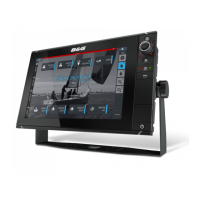| 9
Installation | Loop M User Manual
NMEA 2000 network
A NMEA 2000 network consists of a powered backbone from which drop cables connect
to NMEA 2000 devices. The backbone needs to run within 6 m (20 ft) of the locations of all
products to be connected, typically in a bow to stern layout.
The network requires its own 12 V DC power supply, protected by a 3A fuse.
The following guidelines apply:
• The total length of the backbone should not exceed 100 m (328 ft)
• A single drop cable has a maximum length of 6 m (20 ft). The total length of all drop cables
combined should not exceed 78 m (256 ft)
• The backbone needs to have a terminator at each end of the backbone. The terminator can
be a terminator plug or a unit with built-in terminator
A
A
A
C
C
D
B
B
B
B
E
F
A NMEA 2000 device
B Drop-cable
C Terminator
D Power supply
E Backbone
F OP-Box Loop M/M+ (NMEA 2000 to Naviop CAN)
Naviop CAN network
The Naviop CAN network consists of a backbone from which drop cables connect to the
Egon+ board(s). Each Egon+ board is identified by a CAN ID displayed on the drop-cable.
The Naviop CAN network uses the same components as a NEMA 2000 network.
The OP-Box Loop M/M+ should be installed as a bridge between the networks.
E
C
C
A
D
E
D
G
F
H
A OP-Box Loop M/M+
B Naviop CAN network backbone
C Terminators
D Egon+ drop-cables, maximum length 1.8 m (6 ft)
E Egon+ boards (maximum two Egon+ boards can be installed)
F NMEA 2000 backbone
G NMEA 2000 drop-cable
H Ethernet network (to MFD or Ethernet expansion device)
I MFD

